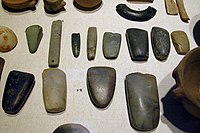
Photo from wikipedia
Abstract In this study, different samples of concrete, containing natural and recycled coarse aggregates and different ratios of nano-silica, were delicately prepared to examine the micro-structure associated material behaviour, and… Click to show full abstract
Abstract In this study, different samples of concrete, containing natural and recycled coarse aggregates and different ratios of nano-silica, were delicately prepared to examine the micro-structure associated material behaviour, and to quantitatively characterize the fracture surfaces after fast dynamic fracture. The first specimen includes 100% of natural aggregates and for the second one, 100% of recycled coarse aggregates were used only. In the other specimens, 0.5%, 1% and 1.5% of nano-silica together with 100% of recycled coarse aggregates were used, respectively. A number of tests including compressive and flexural strength, non-destructive ultrasonic, impact and water penetration tests were conducted for all specimens. Furthermore, scanning electron microscopy (SEM), X-ray computed tomography coupled with image analysis and laser vertical interferometry were employed for the characterization of nano-silica and the impact damaged fracture surfaces of some mixtures. According to the results, recycled coarse aggregate weakened the mechanical properties of the natural coarse aggregate concrete and increased the water permeability. However, it has been demonstrated that this reduction can be mitigated by adding nano-silica into concrete, incorporating recycled coarse aggregate as confirmed by the quantitative X-ray spectroscopy micro-chemical analysis. In addition, it was also concluded from the fractographical surface analysis that nano-silica reduces the pore amount and produces the concrete less porous at the macroscopic level. This, in turn, may stimulate toughening mechanism and crack deflection, leading to low micro-roughness number but high impact resistance during the fast dynamic fracture event.
Journal Title: Construction and Building Materials
Year Published: 2018
Link to full text (if available)
Share on Social Media: Sign Up to like & get
recommendations!